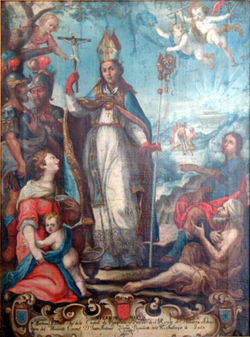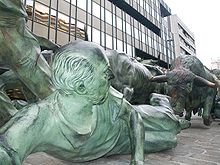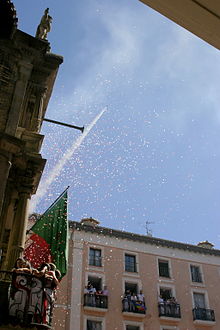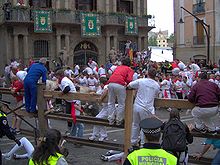- San Fermín
-
San Fermin 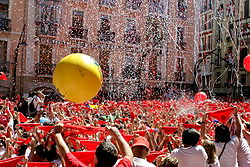
Town Hall of Pamplona seconds before the initiation of the San Fermín festival with the chupinazoOfficial name San Fermín Also called Sanfermín, Sanfermines (plural) Main location Pamplona (Spain) Begins 7 of July; 12 PM Ends 14 of July; 12 AM The festival of San Fermín (or Sanfermines, Basque: Sanferminak) in the city of Pamplona (Navarre, Spain), is a deeply rooted celebration held annually from 12:00, 6 July, when the opening of the fiesta is marked by setting off the pyrotechnic chupinazo,[1] to midnight 14 July, with the singing of the Pobre de Mí. While its most famous event is the encierro, or the running of the bulls, which happens at 8:00 am from July 7th to July 14th, the week-long celebration involves many other traditional and folkloric events. It is known locally as Sanfermines and is held in honor of Saint Fermin, the co-patron of Navarre. Its events were central to the plot of The Sun Also Rises, by Ernest Hemingway, which brought it to the general attention of English-speaking people. It has become probably the most internationally renowned fiesta in Spain. Over 1,000,000 people come to watch this festival.
Contents
History
Saint Fermin
Fermin is said to have been the son of a Roman of senatorial rank in Pamplona in the 3rd century, who was converted to Christianity by Saint Honestus, a disciple of Saint Saturninus. According to tradition, he was baptised by Saturninus (in Navarre also known as Saint Cernin) at the spot now known as the "Small Well of Saint Cernin" [2][3] Fermin was ordained a priest in Toulouse and returned to Pamplona as its first bishop. On a later preaching voyage, Fermin was beheaded in Amiens, France; and is now considered a martyr in the Catholic Church.[3] It is believed he died on September 25, AD 303. There is no written record of veneration in Pamplona of the Saint until the 12th century. Saint Fermin, as well as Saint Francis Xavier, are now the two patrons of Navarre.[3] At Pamplona, Saint Fermin; is now sometimes said to have met his end by being dragged through the streets of Pamplona by bulls, a fate more commonly attributed to his mentor, Saturnin.
Medieval period to the 19th century
The celebration of the festival has its origin in the combination of two different medieval events.[4] Commercial secular fairs were held at the beginning of the summer. As cattle merchants came into town with their animals, eventually bullfighting came to be organized as a part of the tradition.[4] Specifically, they were first documented in the 14th century. On the other hand religious ceremonies honoring the saint were held on October 10.[4] However in 1591 they were transferred to the 7th of July to take place at the same time as the fair; when Pamplona's weather is better.[4] This is considered to be the beginning of the Sanfermines.[4] At that time they lasted two days but they were extended until the 10th and nowadays endure until the 14th.[4] During medieval times acts included an opening speech, musicians, tournaments, theatre, bullfights, dances or even fireworks.[4] Bullrunning appears in 17th and 18th century chronicles together with the presence of foreigners and the first concerns on the excessive drinking and dissolute behavior during the event.[4] The Giant's Parade[5] was created by the end in the mid of the 19th century.[4] The first official bullring was constructed in 1844.
Modern times
The worldwide fame of the modern festival, and the great number of foreign visitors it receives every year, are closely related to the description by Ernest Hemingway's book The Sun Also Rises[6] and his job as a journalist.[7] He was greatly amused in his first visit in 1923 coming back many times until 1959.[7] Hemingway was also deeply fond of bullrunnings and bullfights. Different city locations are famous in part due to the fact that the writer used to visit them, such as the La perla hotel,[7] or the Iruña café.
Single day events
Chupinazo
The opening of the fiesta is marked by setting off the pyrotechnic chupinazo (or txupinazo in Basque language). The rocket is launched at 12:00 noon on the 6th of July from a city hall balcony with thousands of people celebrating the act in the city hall square and other locations in Pamplona. As the square is crowded of people during the chupinazom the use of flip-flops is not advised for this act, although this year it has been forbidden to carry glass bottles.[8]
Riau-Riau
The Riau-Riau was a mass activity held on 6 July. The members of the city council would parade from the City Hall to a nearby chapel dedicated to Saint Fermín. Protesting youths would mass blocking the way, dancing to the Astrain Waltz played by the city band. The councilors would be stuck for hours sometimes being unable to exit the City Hall. The procession was finally removed from the festival calendar for political reasons as extremists used the "Riau-Riau" to promote unrest and clashes with authorities, police and other participants. Nevertheless in recent years it has been held unofficially without the participation of the members of the city council.
San Fermin procession
The most important day of the festival is 7 July, when thousands of people accompany the medieval statue of Saint Fermin along the streets in the old part of Pamplona. Saint Fermín is accompanied by dancers and street entertainers, such as the Gigantes and the Cabezudos and different political and religious authorities.
Pobre de mí
After nine days of partying, the people of Pamplona meet in the Townhall Plaza at midnight on 14 July, singing the traditional mournful notes of the Pobre de Mí ('Poor Me'), in a candlelit ending.
Daily events
Running of the bulls
The running of the bulls[9] involves hundreds of people running in front of six bulls and another six steers down an 825-metre (0.51 mile) stretch of narrow streets of a section of the old town of Pamplona. The event begins at 8 a.m. when a first firecracker is lit to announce the release of the bulls from their corral. It is held between the 7th and the 14th. Runners gather earlier at the beginning of the itinerary to ask for the protection of the Saint by singing a chant three times before a small statue of San Fermin which has been placed in a raised niche in a wall. A second cracker signals that the last bull has left the corral. There are six fighting bulls accompanied by eight not fighting bulls (often white and brown coloured) that guide them to the "plaza" and followed by three more not fighting bulls, the "brush group". There are also some shepherds guiding the bulls, wearing green T-shirts and long poles. The run ends in the Pamplona's bullring taking a mean time of around 3 minutes where the bulls would be held until the afternoons bullfight when they would be killed. Once all of the bulls have entered the arena, a third rocket is released while a fourth firecracker indicates that the bulls are in their bullpens and the run has concluded. The event is dangerous. Since 1925, 15[10] people have been killed during the event –– most recently on 10 July 2009[11] -- and every year between 200 and 300 people are injured during the run although most injuries are contusions due to falls and are not serious.[12] There are several basic rules to respect if you want to run: - Don't try to touch the bulls. You take the risk of getting his attention over yourself. - If you fall down, don't try to raise. Protect your head and lie in fetal position until the group passes. - Notice that a bull runs faster than you and that a single bull is more dangerous than the group. -Take the bend of "Mercaderes" from the interior side, as the bulls often hit or even fall in the exterior side and can squash on the walls. -Don't carry photocameras or backpacks. After the end of the run young cows with wrapped horns [13] are released in the bullring and toss the participants, to the amusement of the crowd.
Giants and big-heads parade
Every day, during the morning, there is a parade of gigantes y cabezudos (in English giants and big-heads respectively), with the giants figures being 150 years old. The eight giants figures were built by the painter from Pamplona Tadeo Amorena in 1860, and represent four pairs of kings and queens of four different races and places (Europe, Asia, America and Africa). Their size is around 4 metres each and are carried by a dancer inside a wooden structure. During the parade giants dance following the rhythm of traditional music. The remaining 17 figures include 6 kilikis, 5 big-heads, and 6 zaldikos and were built at different times between 1860 and 1941. Kilikis and big-heads are caricaturesque, but human-like figures that are carried as helmets. Big-heads masks are up to 1 metre high and kilikis slightly smaller. While big-heads simply precede the giants and wave their hands at spectators, kilikis run after children and carry a foam truncheon which they use to hit them with. Zaldikos are figures representing horses with its hiker and also run after children with a truncheon.[14][15]
Traditional sports
There are exhibitions and competitions of Basque rural sports every morning in the "Plaza de los Fueros", a square close to the city citadel, although they were formerly held in the bullring.[16] Sports include stone lifting, wood cutting, or hay bale lifting.[16] On the other hand the Jai alai tournament of Sanfermin is a prestigious competition of this variety of basque pelota. It is held in one of the courts of the city.[16] Betting is common during these events.[16]
Bullfight
Every afternoon between the 7th and 14th there is a bullfight in which the 6 bulls that have been driven to the bullring during the bullrunning of that day are killed. It begins at 18:30.[17] In addition the 6th a bullfight with younger bulls and not fully trained bullfighters is performed while the 6th features bullfighters on horses (in Spanish "rejoneo"). While the bullring of the city is the third in size of the world, it is full every afternoon and tickets are hard to find.[17]
Fireworks
Every night a firework spectacle is held at the citadel park. Fireworks spectacles have been known to occur in Sanfermin as far back as 1595. Since the year 2000 an international fireworks contest is held.[18] Thousands of people watch them seated on the grass around the citadel.[18]
See Also
- Fiestas of International Tourist Interest of Spain
Notes and references
- ^ The ceremony, which dates to the beginning of the twentieth century, has been accompanied by ever greater ceremony and is now is televised all over the world. (Spanish Wikipedia:"Chupinazo").
- ^ In Spanish: Pocico de San Cernin
- ^ a b c "History of... The saint-Saint San Fermin festival- Sanfermines-tourist information on Navarre". Government of Navarre. http://www.turismo.navarra.es/eng/propuestas/san-fermines/desarrollo/santo.htm. Retrieved 2009-07-23.
- ^ a b c d e f g h i "History of... The fiesta of San Fermín-Saint San Fermin festival- Sanfermines-tourist information on Navarre". Government of Navarre. http://www.turismo.navarra.es/eng/propuestas/san-fermines/desarrollo/fiesta.htm. Retrieved 2009-07-29.
- ^ In Spanish: Comparsa de Gigantes y Cabezudos.
- ^ Also known as Fiesta, which in Spanish means party or carnival
- ^ a b c "History of... Ernest Hemingway-Saint San Fermin festival- Sanfermines-tourist information on Navarre". Navarre tourist office. http://www.turismo.navarra.es/eng/propuestas/san-fermines/desarrollo/hemingway.htm. Retrieved 2009-07-29.
- ^ "The Sanfermines: the "chupinazo"". navarra.com. http://www.navarra.com/english/sanfermin/chupinazo.htm. Retrieved 2009-09-03.
- ^ In Spanish: encierro; from the verb encerrar, to lock/shut up
- ^ Michelle Tsai (July 12, 2007). "I Was Gored by a Bull. Is my life in danger?". Slate Magazine. http://www.slate.com/id/2170302/nav/fix/.
- ^ Giles Tremlett (July 10, 2009). "Bull kills man at Pamplona festival". The Guardian. http://www.guardian.co.uk/world/2009/jul/10/running-bulls-kill-man-pamplona.
- ^ "The Bull Run". Ayuntamiento de Pamplona (Council of Pamplona). http://www.pamplona.net/VerPagina.asp?IdPag=287&Idioma=5. Retrieved 2008-07-21.
- ^ In Spanish: Vaquillas enboladas.
- ^ Juan José Martirena Ruíz (2001). Historias del viejo Pamplona. Pamplona: Ayuntamiento de Pamplona. ISBN 84-89590-90-7.
- ^ Gigantes de Navarra. Pamplona: EGN. 2010. ISBN 978-84-937633-1-2.
- ^ a b c d "Rural Sports". Sanfermines.net. Asociación de empresarios de hostelería de Navarra (Bussinessmen association of hotel and bar's industry of Navarre). http://www.sanfermines.net/ingles/que_hacer_y_ver.php. Retrieved 2010-09-26.
- ^ a b "The bulls... The corrida-San Fermin". Oficina de turismo de Navarra (Navarre tourist office). http://www.turismo.navarra.es/eng/propuestas/san-fermines/desarrollo/corrida.htm. Retrieved 2010-08-25.
- ^ a b "Fireworks". Sanfermines.net. Asociación de empresarios de hostelería de Navarra (Bussinessmen association of hotel and bar's industry of Navarre). http://www.sanfermines.net/ingles/fuegos.php. Retrieved 2010-09-26.
External links
- Fiesta of San Fermin at Spanish National Television website, RTVE.es
- The running of the bulls Encierros San Fermín Live at 07.15 AM Central European Time, GMT+2
- The opening of the fiesta, chupinazo 2010
- Official guide to the fiesta of San Fermin.
- Unofficial website on San Fermin and on encierro
Traditional festivals in Spain Major traditional festivals Albacete Fair · Batalla de flores · Bonfires of Saint John · Carnival of Cádiz · Carnival of Santa Cruz de Tenerife · Cavalcade of Magi · Chiviri · Cincomarzada · Coso Blanco · Cider Festival · Descenso del Sella · Falles · Feast of the Pirates of Premià de Mar · Fiestas de San Juan · Fiestas del Pilar · Haro Wine Festival · Hita Medieval Festival · Holy Week · Horse Fair · Horse Racing of Sanlúcar Beach · Los Campanos · Maruxaina · La Mercè · Misteri d'Elx · Moros y cristianos · Paso del Fuego · Patum de Berga · Powder Day · Romería de El Rocío · Saint John of the Mountain Festival · Santa Tecla Festival · San Fermín · Seville Fair · Tamborrada · Tarragona Fireworks Competition · Tomatina · Andra Mari Zuriaren JaiakOther related topics Musical events Music festivalsCategories:- Festivals in Spain
- Secular holidays
- July observances
- Navarre
Wikimedia Foundation. 2010.

